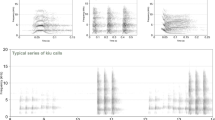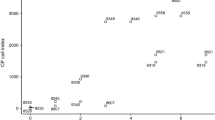Abstract
Volunteer-based audio surveys are used to document long-term trends in anuran community composition and abundance. Current sampling protocols, however, are not region- or species-specific and may not detect relatively rare or audibly cryptic species. We used automated audio recording devices to record calling anurans during 2006–2009 at wetlands in Maine, USA. We identified species calling, chorus intensity, time of day, and environmental variables when each species was calling and developed logistic and generalized mixed models to determine the time interval and environmental variables that optimize detection of each species during peak calling periods. We detected eight of nine anurans documented in Maine. Individual recordings selected from the sampling period (0.5 h past sunset to 0100 h) described in the North American Amphibian Monitoring Program (NAAMP) detected fewer species than were detected in recordings from 30 min past sunset until sunrise. Time of maximum detection of presence and full chorusing for three species (green frogs, mink frogs, pickerel frogs) occurred after the NAAMP sampling end time (0100 h). The NAAMP protocol’s sampling period may result in omissions and misclassifications of chorus sizes for certain species. These potential errors should be considered when interpreting trends generated from standardized anuran audio surveys.


Similar content being viewed by others
References
Agresti A (2007) An introduction to categorical data analysis. Wiley, Hoboken
Bevier CR, Larson K, Reilly K, Tat S (2004) Vocal repertoire and calling activity of the mink frog, Rana septentrionalis. Amphibia-Reptilia 25:255–264
Bevier CR, Tierney DC, Henderson LE, Reid HE (2006) Chorus attendance and site fidelity in the mink frog, Rana septentrionalis: are males territorial. Journal of Herpetology 40:160–164
Brandes TS (2008) Automated sound recording and analysis techniques for bird surveys and conservation. Bird Conservation International 18:163–173
Bridges AS, Dorcas ME (2000) Temporal variation in anuran calling behavior: implications for surveys and monitoring programs. Copeia 2:587–592
Burnham KP, Anderson DR (2002) Model selection and multimodal inference: practical information theoretic approach. Springer Science, New York
Crouch WB III, Paton PWC (2002) Assessing the use of call surveys to monitor breeding anurans in Rhode Island. Journal of Herpetology 36:185–192
R Development Core Team (2010) R: a language and environment for statistical computing. R Foundation for Statistical Computing, Vienna, Austria. ISBN 3-900051-07-0, URL http://www.R-project.org
Dorcas ME, Price SJ, Walls SC, Barichivich WJ (2009) Auditory monitoring of anuran populations. In: Dodd CK Jr (ed) Amphibian ecology and conservation. Oxford University Press, New York, pp 281–298
Ficetola GF, Coic C, Detaint M, Berroneau M, Lorvelec O, Miaud C (2007) Pattern of distribution of the American bullfrog (Rana catesbeianus) in Europe. Biological Invasions 9:767–772
Gibbs JP, Whiteleather KK, Schueler FW (2005) Changes in toad populations over 30 years in New York State. Ecological Applications 15:1148–1157
Granda JR, Pena RM, Pierce BA (2008) Effects of disturbance, position of observer, and moonlight on efficiency of anuran call surveys. Applied Herpetology 5:253–263
Hinshaw S (1999) Northern leopard frog, Rana pipiens. In: Hunter ME Jr, Calhoun AJK, McCollough MM (eds) Maine amphibians and reptiles. The University of Maine Press, Orono, pp 101–106
Hunter ME Jr, Calhoun AJK, McCollough MM (1999) Maine amphibians and reptiles. The University of Maine Press, Orono
Krohn WB, Boone RB, Painton SL (1999) Quantitative delineation and characterization of hierarchical biophysical regions of Maine. Northeastern Naturalist 6:139–164
Lotz A, Allen CR (2007) Bias in anuran call surveys. The Journal of Wildlife Management 71:675–679
MacKenzie DI, Nichols JD, Royle JA, Pollock KH, Bailey LA, Hines JE (2006) Occupancy modeling and estimation. Elsevier, San Diego
MacKenzie DI, Nichols JD, Seamans ME, Gutierrez RJ (2009) Modeling species occurrence dynamics with multiple states and imperfect detection. Ecology 90:823–835
McClintock BT, Bailey LL, Pollock KH, Simons TR (2010) Unmodeled observation error induces bias when inferring patterns and dynamics of species occurrence via aural detections. Ecology 91:2446–2464
Miller DA, Nichols JD, McClinktock BT, Campbell Grant EH, Bailey LL, Weir LA (2011) Improving occupancy estimation when two types of observation error occur: non-detection and species misidentification. Ecology 92:1422–1428
Mossman MJ, Hartman LM, Hay R, Sauer JR, Dhuey BJ (1998) Monitoring long-term trends in Wisconsin frog and toad populations. In: Lannoo MJ (ed) Status and conservation of mid-western amphibians. University of Iowa Press, Iowa City, pp 169–205
Nelson GL, Graves BM (2004) Anuran population monitoring: comparison of the North American Amphibian Monitoring Program’s calling index with mark-recapture estimates for Rana clamitans. Journal of Herpetology 38:355–359
Nichols JD, Hines JE, MacKenzie DI, Seamans ME, Guitierrez RJ (2007) Occupancy estimation and modeling with multiple states and state uncertainty. Ecology 88:1395–1400
Oseen KL, Wassersug RJ (2002) Environmental factors influencing calling in sympatric anurans. Oecologia 133:616–625
Peterson CR, Dorcas ME (1992) The use of automated data-acquisition techniques in monitoring amphibian and reptile populations. In: McCullough DR, Barrett R (eds) Wildlife 2001: populations. Elsevier Applied Science, London, pp 369–378
Pierce BA, Gutzwiller KJ (2004) Auditory sampling of frogs: detection efficiency in relation to survey duration. Journal of Herpetology 38:495–500
Popescu VP, Gibbs JP (2009) Interactions between climate, beaver activity, and pond occupancy by the cold-adapted mink frog in New York State, USA. Biological Conservation 142:2059–2068
Royle JA (2004) Modeling abundance index data from anuran calling surveys. Conservation Biology 18:1378–1385
Royle JA, Link WA (2005) A general class of multinomial mixture models for anuran calling survey data. Ecology 86:2505–2512
Saenz D, Fitzgerald LA, Baum KA, Conner RN (2006) Abiotic correlates of anuran calling phenology: the importance of rain, temperature, and season. Herpetological Monographs 20:64–82
Shearin AF (2012) Influence of landscape arrangement and wetland condition on breeding dynamics of Ambystoma maculatum (spotted salamander) in Maine, USA. Doctoral Dissertation, University of Maine, Orono. 236 pp
Schilling EG, Loftin CS, DeGoosh KE, Huryn AD, Webster KE (2008) Predicting the locations of naturally fishless lakes. Freshwater Biology 53:1021–1035
Schilling EG, Loftin CS, Huryn AD (2009) Effects of introduced fish on macroinvertebrate communities in historically fishless headwater and kettle lakes. Biological Conservation 142:3030–3038
Shirose LJ, Bishop CA, Green DM, MacDonald CJ (1997) Validation tests of an amphibian call count survey technique in Ontario, Canada. Herpetologica 53:312–320
Sprent P, Smeeton NC (2001) Applied nonparametric statistical methods. Chapman & Hall/CRC, Boca Raton
Steelman CK, Dorcas ME (2010) Anuran calling survey optimization: developing and testing predictive models of anuran calling activity. Journal of Herpetology 44:61–68
Stockwell S (1999) Mink frog, Rana septentrionalis. In: Hunter ME Jr, Calhoun AJK, McCollough MM (eds) Maine amphibians and reptiles. The University of Maine Press, Orono, pp 107–110
Taigen TL, Wells KD, Marsh RL (1985) The enzymatic basis of high metabolic rates in calling frogs. Physiological Zoology 58:719–726
Tupper TA, Cook RP, Timm BC, Goodstine A (2007) Improving calling surveys for detecting Fowler’s toad, Bufo fowleri, in southern New England, USA. Applied Herpetology 4:245–259
Veysey JS, Babbitt KJ, Cooper A (2009) An experimental assessment of buffer width: implications for salamander migratory behavior. Biological Conservation 142:2227–2239
Weir LA, Mossman MJ (2005) North American Amphibian Monitoring Program (NAAMP). In: Lannoo M (ed) Amphibian declines: the conservation status of United States species. University of California Press, Berkeley, pp 307–313
Weir LA, Royle JA, Nanjappa P, Jung RE (2005) Modeling anuran detection and site occupancy on North American amphibian monitoring program (NAAMP) routes in Maryland. Journal of Herpetology 39:627–639
Weir LA, Fiske IJ, Royle JA (2009) Trends in anuran occupancy from northeastern states of the North American Amphibian Monitoring Program. Herpetological Conservation and Biology 4:389–402
Wells KD (1977) The social behavior of anuran amphibians. Animal Behavior 25:666–693
Wells KD, Taigen TL, O’Brien JA (1996) The effect of temperature on calling energetic of the spring peeper (Pseudacris crucifer). Amphibia-Reptilia 17:149–158
Zuur AF, Ieno EN, Walker NJ, Saveliev AA, Smith GM (2009) Mixed effects models and extensions in ecology with R. Springer Science, New York
Acknowledgments
This research was supported by funds provided by the U.S. Geological Survey, Maine Cooperative Fish and Wildlife Research Unit, the Maine Department of Inland Fisheries and Wildlife, the University of Maine, and the Maine Association of Wetland Scientists. We thank B. Agius, D. Bavaro, G. Dixon, L. Keener-Eck, D. Morgan, J. Noll, J. Rowe, J. Shrader, J. Torzewski, and J. White for assistance in the field and laboratory. We thank landowners in western and Downeast Maine for access to lakes and wetlands on their properties. Automated recording systems were generously constructed by K. Lesniewicz and G. Dixon (University of Maine) or loaned by L. Bailey (USGS-Patuxent Wildlife Research Center). The research was improved by guidance and recommendations from W. Halteman, K. Simon, and W. Glanz. Review comments provided by L. Bailey, L. Weir, and two anonymous reviewers improved the manuscript. Mention of trade names or commercial products does not constitute endorsement or recommendation for use by the U.S. Government. This is University of Maine Agricultural and Forest Experiment Station Publication Number 3257.
Author information
Authors and Affiliations
Corresponding author
Appendices
Appendix 1
Appendix 2
Appendix 3
Mean Calling Index (CI) ± 1 standard error by hour after sunset for eight species: a gray treefrog, b bullfrog, c green frog, d pickerel frog, e northern leopard frog, f mink frog, g wood frog, and, h spring peeper. Individual recordings originally measured in minutes after sunset were grouped into hours after sunset to produce mean CI
Appendix 4
Rights and permissions
About this article
Cite this article
Shearin, A.F., Calhoun, A.J.K. & Loftin, C.S. Evaluation of Listener-Based Anuran Surveys with Automated Audio Recording Devices. Wetlands 32, 737–751 (2012). https://doi.org/10.1007/s13157-012-0307-7
Received:
Accepted:
Published:
Issue Date:
DOI: https://doi.org/10.1007/s13157-012-0307-7







